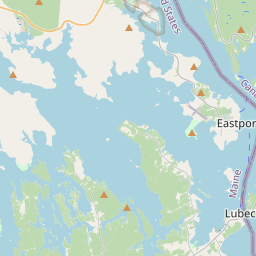Inscription
Vue Panoramique des Ridences d'?te
Two of the Campobello Company's founders, Alex S. Porter and Samuel Wells, and several of the luxury hotel visitors, including James Roosevelt and families by the name of Sturgis, Cochrane, Prince, and Pell purchased land and refurbished or built large cottages. Five cottages remain today: the Prince, Roosevelt, Hubbard, Wells-Shober, and Johnston cottages in what is now the Roosevelt Campobello International Park's historic core.This circa 1914 photo identifies the various structures seen then from the slopes of Friar's Head.
There was no real forest on this end of Campobello at the turn of the last century, for during the early and mid-1800s, island residents cleared most of the land between Welshpool and Friar's Head for planting crops and grazing livestock. Remnants of old fields and apple trees now surrounded by alders or spruce trees help identify historic land use. Hidden by vegetation are old wells and sections of building foundations of former homes, cottages, and barns. The wells have been covered for safety.
—————————
Par la suite, deux des fondateurs de la Campobello Company, Alex S. Porter et Samuel Wells, ainsi que plusieurs autres visiteurs ayant fait des s?jours dans les h?tels de l'?le - y compris James Roosevelt et les familles Sturgis, Cochrane, Prince et Pell - acqui?rent plusieurs terres et entreprirent la restauration et la construction de larges ridences d'?t?. On y retrouve aujourd'hui cinq ridences d'?t?, dont celles des Prince, Roosevelt, Hubbard, Wells-Shober et Johnston. Celles-ci forment dormais la majeure partie du patrimoine historique du Parc International Roosevelt de Campobello.
Cette photo prise aux environs de 1914 t?moigne des nombreuses structures que l'on pouvait apercevoir alors sur les collines du cap Friar.
Les for?ts denses n'existaient plus vraiment ? cette extr?mit? de l'?le de Campobello ? la fin du dernier si?cle. Au d?but et vers le milieu des ann?es 1880, les habitants de l'?le ont d?frich? la plupart des terres entre Welshpool et la cap Friar pour des fins agricoles et pour y faire la culture et la p?turage. Un nombre d'aulnes et d'?pinettes occupent maintenant les champs et les vergers de pommes qui existaient ? l'?poque. On peut ?galement apercevoir de vieux puits et les sections des fondations d'anciennes ridences et granges. On a condamn? les puits pour des raisons de s?curit?.
—————————
The photo is from a Real Photo Post Card kindly loaned by Robin H. Wyllie.
Cette photo est une reproduction d'une carte postale d'?poque qui nous a g?n?reusement ?t? pr?t?e par Robin H. Wyllie.
Details
| HM Number | HM178K |
|---|---|
| Tags | |
| Placed By | Roosevelt Campobello International Park |
| Marker Condition | No reports yet |
| Date Added | Friday, September 12th, 2014 at 9:47pm PDT -07:00 |
Pictures
Locationbig map






| UTM (WGS84 Datum) | 19T E 660187 N 4971204 |
|---|---|
| Decimal Degrees | 44.87625000, -66.97191667 |
| Degrees and Decimal Minutes | N 44° 52.575', W 66° 58.315' |
| Degrees, Minutes and Seconds | 44° 52' 34.50" N, 66° 58' 18.90" W |
| Driving Directions | Google Maps |
| Area Code(s) | 831 |
| Closest Postal Address | At or near 98 Unnamed Road, Welshpool NB E5E 1B3, CA |
| Alternative Maps | Google Maps, MapQuest, Bing Maps, Yahoo Maps, MSR Maps, OpenCycleMap, MyTopo Maps, OpenStreetMap |
Is this marker missing? Are the coordinates wrong? Do you have additional information that you would like to share with us? If so, check in.
Nearby Markersshow on map
Roosevelt Campobello International Park
Mulholland Point / La Pointe Mulholland
Passamaquoddy Tidal Power Project
Passamaquoddy Tribe / La Tribu Passamaquoddy
Friar's Head / Le Cap Friar
Campobello Company and Hotels
President Franklin Delano Roosevelt
Roosevelt Campobello Park
James and Sara Roosevelt Cottage
Summer Activities
Maintenance Issues
- Is this marker part of a series?
- What historical period does the marker represent?
- What historical place does the marker represent?
- What type of marker is it?
- What class is the marker?
- What style is the marker?
- Does the marker have a number?
- What year was the marker erected?
- This marker needs at least one picture.
- Can this marker be seen from the road?
- Is the marker in the median?

Comments 0 comments